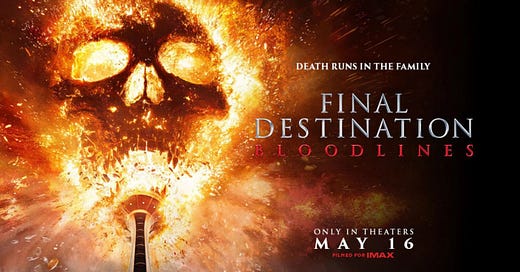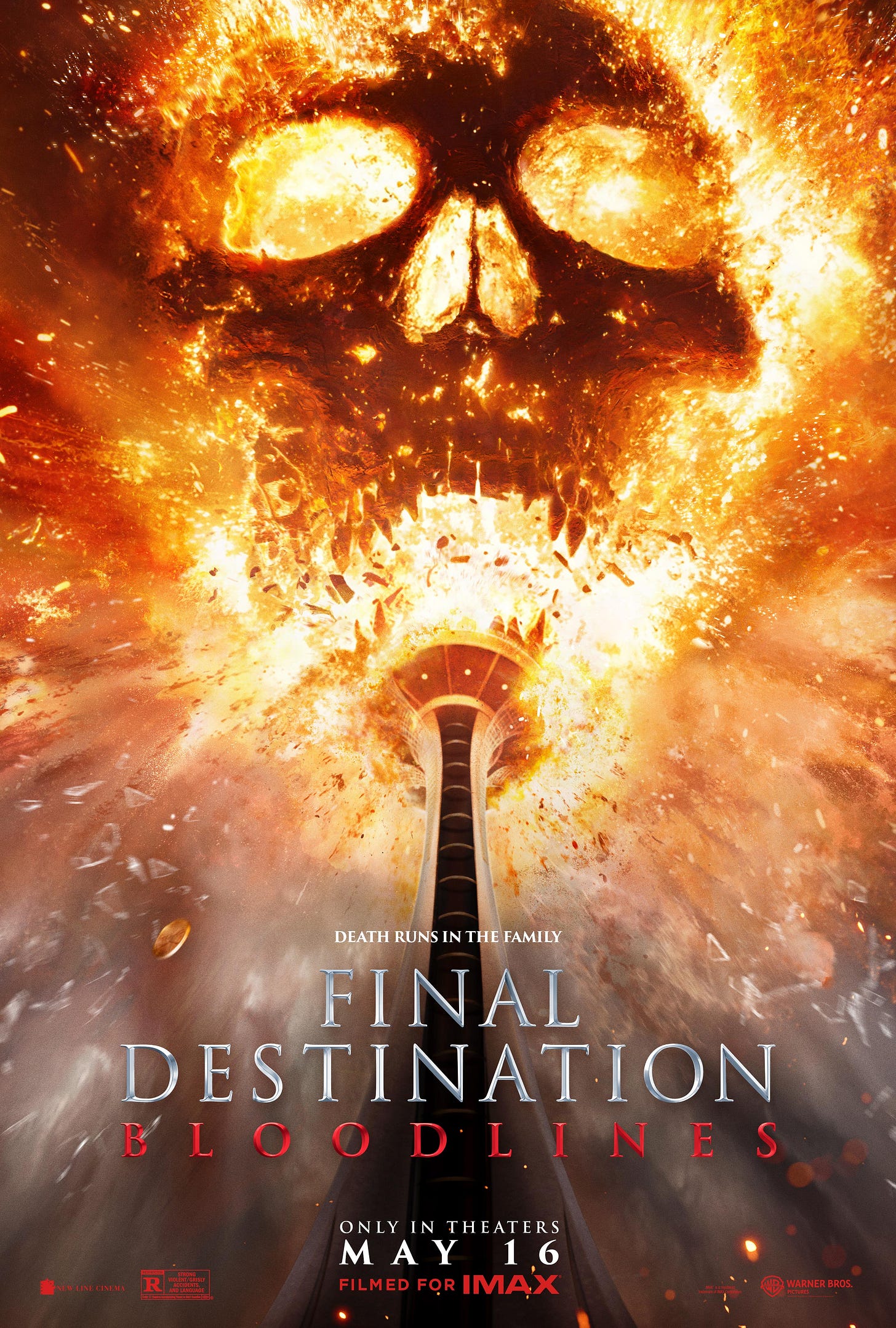Review: 'Final Destination: Bloodlines'
The prologue rocks, but otherwise, this initially HBO Max-intended sequel looks and feels streaming-small. At least it doesn’t rely on nostalgia and callbacks.
Final Destination: Bloodlines (2025)
111 minutes/rated R for “violent/grisly accidents and language”
Directed by Zach Lipovsky and Adam Stein
Written by Guy Busick and Lori Evans Taylor
Story by Jon Watts, Guy Busick and Lori Evans Taylor
Based on characters created by Jeffre Reddick
Produced by Craig Perry, Sheila Hanahan Taylor, Jon Watts, Dianne McGunigle, Toby Emmerich
Starring - Kaitlyn Santa Juana, Teo Briones, Richard Harmon, Owen Patrick Joyner, Rya Kihlstedt, Anna Lore, Tinpo Lee, Alex Zahara, Brec Bassinger, Max Lloyd-Jones and Tony Todd
Cinetography by Christian Sebaldt, Edited by Sabrina Pitre, Music by Tim Wynn
Production companies - New Line Cinema, Practical Pictures, Freshman Year, Fireside Films
Opening the week of May 16, 2025, courtesy of Warner Bros. Pictures
One issue with previously streaming-bound films receiving a big-screen promotion is that sometimes you can tell it wasn’t intended to play at a theatre near you. With a dependence on distractingly cartoonish CGI blood for the payoffs and a cast of mostly unknown actors, Final Destination Bloodlines bears all the hallmarks of a “straight-to-video” sequel to a once theatrically viable franchise. Thus, it’s a bit ironic that this sixth installment is opening in the prime pre-Memorial Day weekend slot (see also - the Star Wars prequels, all four Shrek films, and Matrix Reloaded among many others) and securing an IMAX engagement. On one hand, we’re at the point where every theatrical release is a gift to a still-struggling theatrical ecosystem. On the other hand, how much extra credit should an IP-for-IP’s sake continuation of a property that once stood out by being new and creative receive just because it wasn’t buried on a streaming platform?
The good news is that horror films don’t necessarily need a huge budget to succeed. As Child’s Play fans will tell you (Curse of Chucky > the previous four Child’s Play sequels), sometimes the “back to basics” non-theatrical follow-ups can offer a creative resurgence or simply turn out better than some of the multiplex-intended installments. That’s not quite the case here, even if (by default) Bloodlines is better than The Final Destination. Of course, the 2009 sequel was slightly less exciting than staring at a blank screen for 90 minutes. While this relaunch, thankfully neither a reboot nor a nostalgia-chasing legacy sequel, suffers from its lack of old-school production value, it still works as a “Fine, whatever” Final Destination movie. If I seem overly harsh, it’s because (through no fault of a game cast of mostly fresh faces) the film starts on a sky-high note (literally and figuratively) and becomes less compelling as it progresses.
The extended opener drops us into the glitzy opening night ceremony for the Space Needle Sky View Restaurant Tower. Without context or preamble, we are thrust into a comparatively spectacular sequence set in 1969, evoking, in a positive way, the infamous Ghost Ship prologue. Yes, the distracting CGI undermines some gruesome payoffs, but the clever staging and trip-wire tension get the job done. After that, we cut to the present day, where an otherwise exceptional college student (Kaitlyn Santa Juana) is on the cusp of failing out of school due to stress stemming from a recurring nightmare. To the film’s credit, we receive the necessary past-tense exposition pretty quickly, leading to a solo road trip to visit her estranged and paranoid survivalist grandmother. After another exposition dump and one unhappy accident, young Stefani realizes that her family, at least her mother’s side of the family, descends from people who were not supposed to be born.
The title “Bloodlines” does not refer, thank goodness, to our new protagonist turning out to be the secret daughter of Alex Browning and Clear Rivers. The Final Destination gimmick playing out amid a close-knit family unit qualifies as a clever new idea. However, the picture doesn’t necessarily exploit the premise for maximum emotional melodrama. That’s not a surprise, since this franchise exists in its current form because test screening audiences rejected a tonally consistent downer finale for the first Final Destination in favor of a “funny” final cut-to-black killing. I’ve often noted the extent to which Final Destination resembles the Ice Age films, in which a “real movie” about mortality, grief, and the notion of your choices having consequences in a world of random upheavals spawned a series of increasingly “just for fun” cartoons. In terms of those more cartoonish sequels, this is still, without being aggressively “bad,” technically inferior to three of the first four follow-ups.
Tony Todd makes a cameo in a scene that bemusingly shatters the fourth wall, with the beloved horror icon appearing understandably frail and knowing that he’s rounding third base. The fact that the sequence doesn’t explicitly negate past-tense continuity while not being beholden to it now qualifies as refreshingly unique. Regarding the core cast, Juana (who looks like a younger incarnation of the admittedly ageless Aimee Garcia) anchors the proceedings reasonably well. At the same time, Richard Harmon overdelivers as an unexpectedly protective and amusingly proactive older cousin. The “reason for the season” set pieces are a mix of grimly intimate (a slow-burn sequence involving broken glass is a highlight) and larger-scaled but less authentically constructed (maybe I’m wrong, but I’m not sure that MRI machines can… do… that). Aside from the sheer scale of the prequel, there’s nothing that holds a candle to the all-time gymnastics sequence from (the surprisingly good) Final Destination 5.
In terms of IP for IP’s sake, there are worse franchises to revive. Final Destination was initially just a solid horror tragedy that spoke to the anxieties of the post-Columbine/pre-9/11 early 2000s generation (with the sequels existing alongside the Saw films as definitive 9/11 era horror flicks). Yet, the “Mouse Trap Meets Halloween” formula can be applied to any situation, setting, or character set. The core “hot people getting Rube Goldberg-ed to death” concept remains enticing enough to lure fans and those indifferent to the prior installments. However, I wish this were a better Final Destination movie, or at least that it looked and felt as “big” as its predecessors. We are thankfully past the era of being automatically grateful for a previously streaming-bound franchise flick going theatrical. They ought to at least contain more than a little effort, think Blue Beetle and Alien: Romulus, to look and feel like they belong on the big screen.






